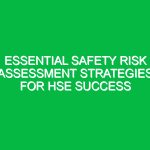Welcome to the Toolbox Talk
Hello, team! Thank you for joining today’s toolbox talk. As we prepare to dive into our day’s work, I want to take a moment to discuss a critical Safety issue that affects us all: Distracted Driving. Whether we’re on the road for business or running errands for our jobs, remaining focused while driving is essential for our Safety and the safety of those around us. In this talk, we will cover what constitutes Distracted Driving, its risks, and Best Practices to help us combat this issue effectively.
Understanding Distracted Driving
Distracted Driving refers to any activity that diverts attention from driving. This includes visually looking away from the road, manually handling items, or cognitively taking your mind off the task at hand. According to the National Highway Traffic Safety Administration (NHTSA), distracted driving claimed 3,142 lives in 2019 alone. It’s crucial that we acknowledge this issue as it directly impacts our Workplace Safety and productivity.
The Three Main Types of Distractions
- Visual Distractions: Anything that causes you to look away from the road, such as checking your phone or adjusting the radio.
- Manual Distractions: Activities that require you to take your hands off the wheel, like eating, drinking, or reaching for items in the car.
- Cognitive Distractions: Thoughts that take your mind off driving, such as daydreaming or stressing about work-related issues.
Why Distracted Driving Matters
Understanding the implications of distracted driving is essential. Aside from the obvious risk of accidents, distracted driving can lead to significant workplace consequences, including:
- Increased insurance premiums
- Legal liabilities for the company
- Increased healthcare costs due to potential injuries
- Loss of productivity due to accidents or injuries
Moreover, when we are responsible for company vehicles or equipment, we must remain vigilant. A single moment of distraction can cause irreversible harm, not only to ourselves but to our colleagues and the public.
Real-Life Scenarios to Consider
Let’s examine a few scenarios that illustrate the importance of avoiding distractions while driving:
Scenario 1: The Text Message
Imagine you’re driving to a client meeting. Your phone buzzes with a text message. You glance down to read it, thinking it will only take a second. In that moment, you miss a stop sign and cause an accident. Not only do you jeopardize your safety, but you also impact the other parties involved.
Scenario 2: The Coffee Run
Picture this: you decide to grab a coffee on your way to work. You’re juggling the cup in one hand while trying to navigate the road with the other. Suddenly, a pedestrian steps onto the street. Your inability to react quickly could have serious consequences.
Both scenarios emphasize the need for full attention while driving. When we are behind the wheel, our sole focus must be on the road.
Best Practices to Combat Distracted Driving
So, how can we combat distracted driving effectively? Here are some Best Practices:
1. Create a Distraction-Free Zone
Before you start driving, ensure your Environment is distraction-free. Secure loose items that can move around and silence your phone to avoid temptation.
2. Use Technology Wisely
Utilize hands-free devices if you must take calls. Many modern vehicles come equipped with Bluetooth technology, allowing you to communicate without handling your phone.
3. Plan Ahead
Before starting your trip, plan your route. If you need to consult a map or GPS, do it before you begin driving. Familiarize yourself with the route to minimize the need for distractions while on the road.
4. Avoid Multitasking
Focus solely on driving. Eating, grooming, or engaging in conversations can take your focus away from the road. If you need to do these activities, pull over to a safe location first.
5. Educate and Encourage Peers
Share your commitment to safe driving with your coworkers. Encourage them to join you in minimizing distractions. A collective approach to safety can help reinforce good habits among your team.
Regulations and Standards on Distracted Driving
It’s vital to be aware of the legal implications of distracted driving. Many regions have enacted laws prohibiting handheld device use while driving. Companies may also have internal policies regarding the use of mobile devices during work hours. Understanding and adhering to these Regulations helps protect you and the company legally and ethically.
Open Discussion
Before we wrap up this toolbox talk, I invite you to share your thoughts. Have you ever faced a situation involving distracted driving? What strategies have you found effective in avoiding distractions? Sharing experiences can foster a supportive atmosphere where we learn from each other.
Conclusion
In conclusion, combating distracted driving is a shared responsibility that requires our full attention and commitment. Remember the key points discussed today: eliminate distractions, utilize technology wisely, and always prioritize safety over convenience. By adopting these practices, we enhance our Workplace Safety and contribute to a culture of responsibility and care.
Thank you for your attention and commitment to making our workplace safer. Let’s continue to support each other and stay focused on the road ahead!


